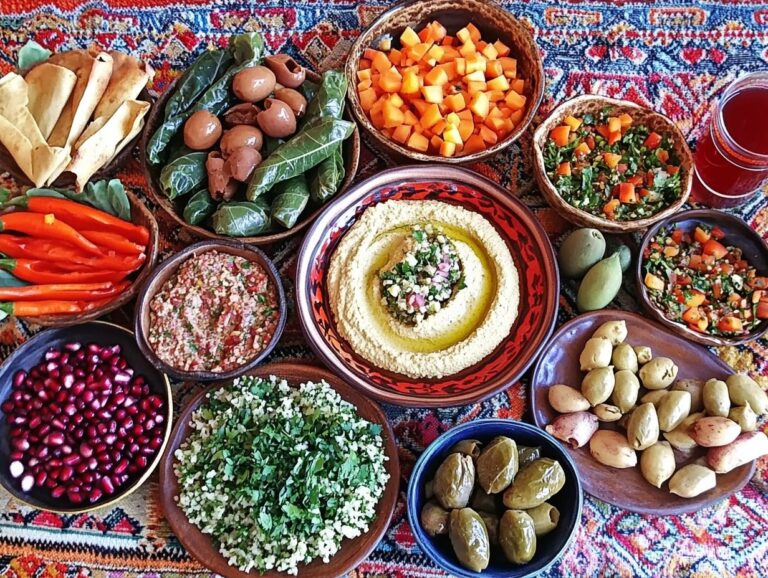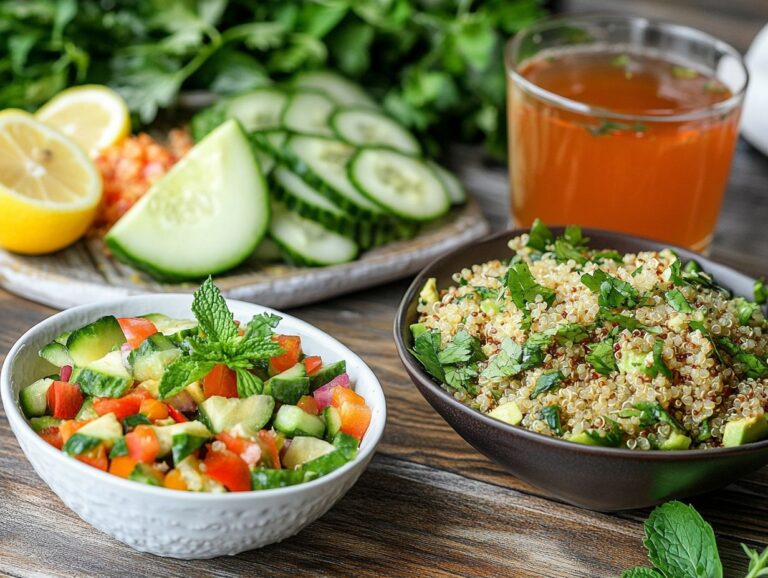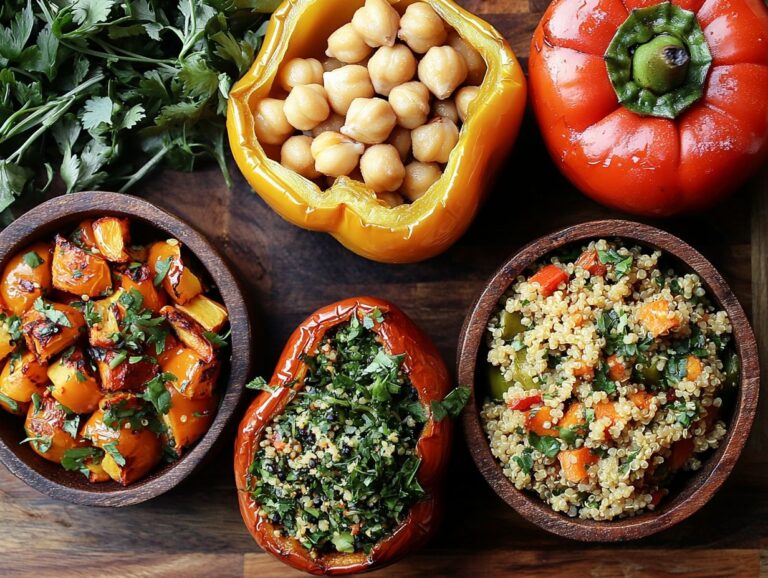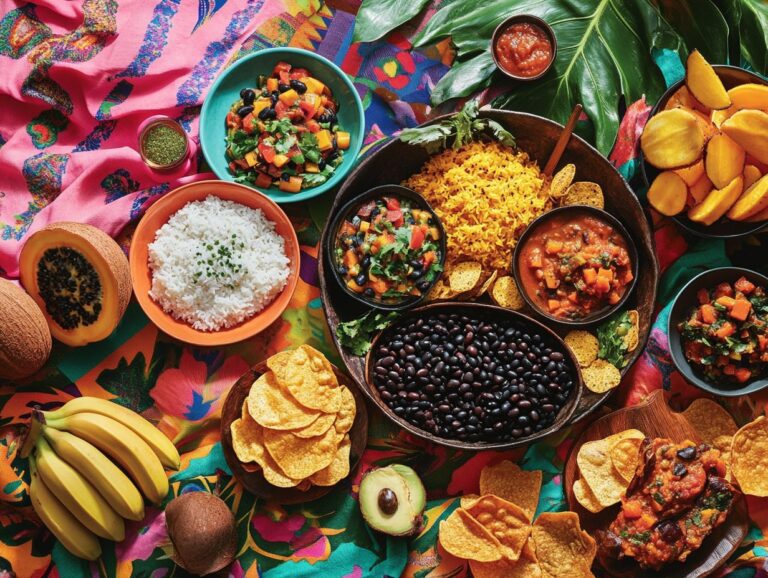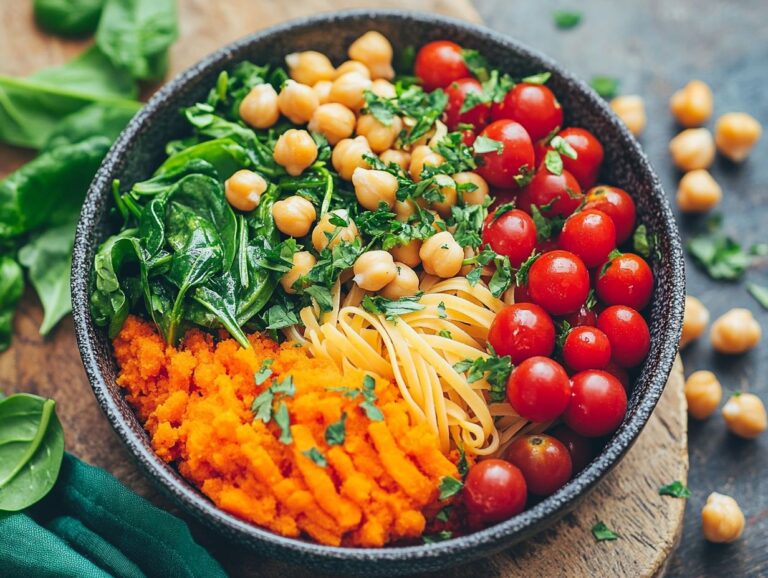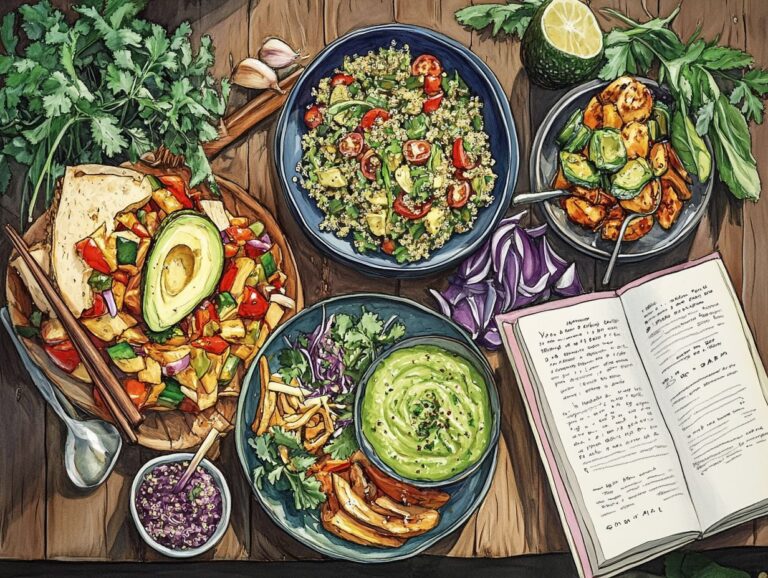Brazilian cuisine boasts a rich history and diverse cultural influences, resulting in a unique combination of flavors, ingredients, and cooking techniques. Influences from the tropical regions of Brazil, such as Bahia, are evident in the culinary traditions that incorporate ingredients like coconut milk, plantains, and bananas. As more people around the world embrace plant-based diets, the realm of vegan Brazilian dishes is gaining attention, with plant-based variations of traditional dishes becoming increasingly popular. This exploration includes information on traditional ingredients, common Brazilian staples, and suitable substitutes for vegans, as well as popular dishes such as Feijoada and Moqueca. Additionally, tips for cooking with Latin American flavors and delicious vegan recipes that capture the essence of Brazil are provided for those interested in enjoying a plant-based take on their favorite dishes.
History and Cultural Influences
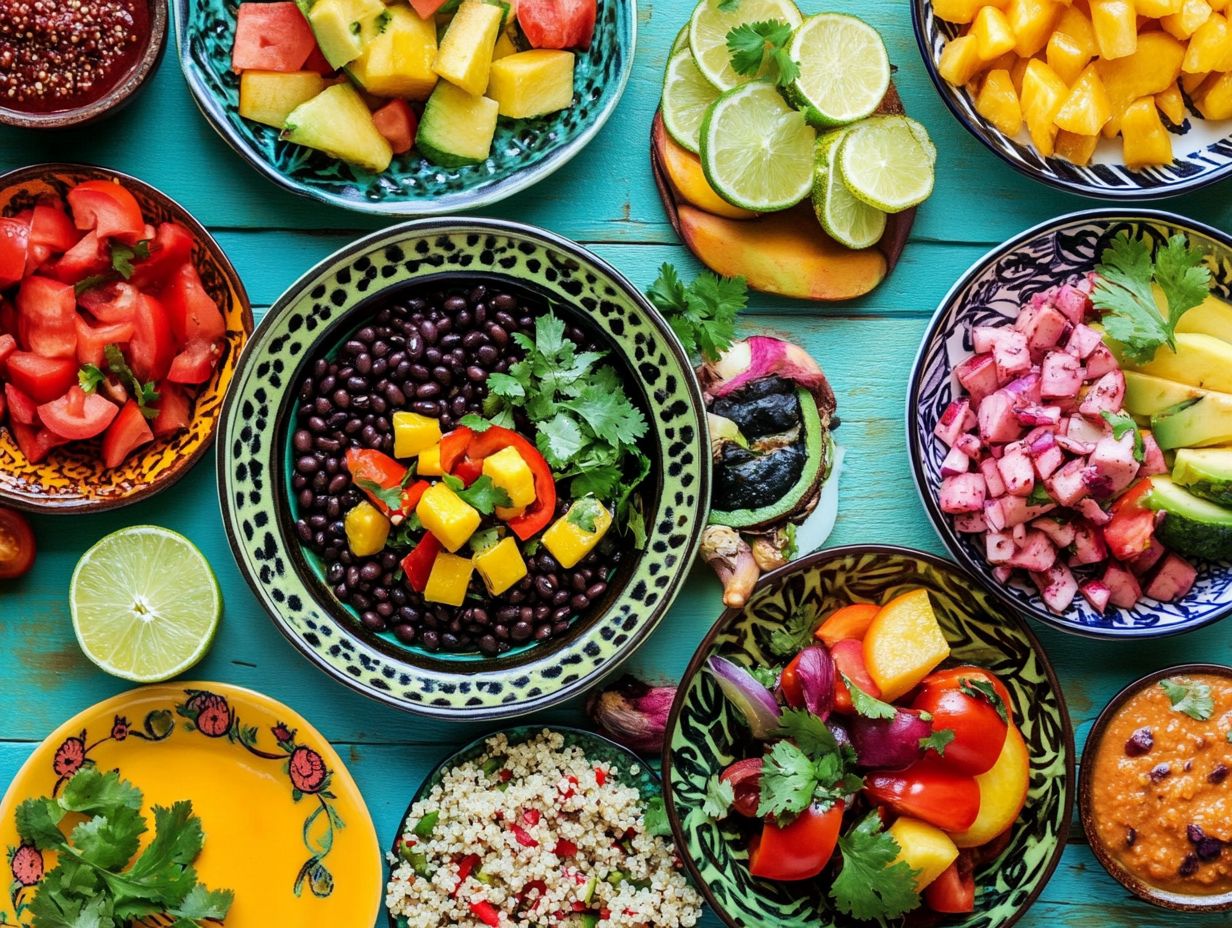 The history of Brazilian cuisine reflects the diverse cultures that have shaped the country, with significant influences from indigenous peoples, Portuguese colonization, and African heritage. These culinary influences are evident in the country’s wide array of traditional dishes, such as moqueca, a Brazilian stew made with coconut milk, spices like ginger and sweet paprika, and fish sourced from coastal fishing communities. Ingredients like cassava, plantains, various beans, rice, and corn highlight Brazil’s agricultural richness, with each geographic region boasting its own specialties, such as the vibrant markets of Copacabana Beach in Rio de Janeiro. For instance, the Amazon is renowned for its exotic fruits and fish, while the Southern states are famous for barbecues and hearty meats. Brazilian culinary dishes not only showcase the country’s geography but also reflect the historical relationships that have developed over centuries among the different cultures that have come to Brazil. Each meal tells a story, and as the nation’s history has evolved, so too has its cuisine.
The history of Brazilian cuisine reflects the diverse cultures that have shaped the country, with significant influences from indigenous peoples, Portuguese colonization, and African heritage. These culinary influences are evident in the country’s wide array of traditional dishes, such as moqueca, a Brazilian stew made with coconut milk, spices like ginger and sweet paprika, and fish sourced from coastal fishing communities. Ingredients like cassava, plantains, various beans, rice, and corn highlight Brazil’s agricultural richness, with each geographic region boasting its own specialties, such as the vibrant markets of Copacabana Beach in Rio de Janeiro. For instance, the Amazon is renowned for its exotic fruits and fish, while the Southern states are famous for barbecues and hearty meats. Brazilian culinary dishes not only showcase the country’s geography but also reflect the historical relationships that have developed over centuries among the different cultures that have come to Brazil. Each meal tells a story, and as the nation’s history has evolved, so too has its cuisine.
Traditional Ingredients in Brazilian Cuisine
Brazilian cuisine is celebrated for its diverse array of traditional ingredients that define many of the country’s most famous dishes. Staples such as rice, beans, and cassava are integral to a variety of meals across the nation. Fresh vegetables and herbs, including peppers and bananas, are also commonly used in Brazilian cooking, enhancing the flavors of its dishes. The local ingredients sourced from Brazil’s tropical climate are essential to the taste of traditional recipes, establishing Brazil as one of the most significant culinary destinations in Latin America.
Common Staples and Substitutes for Vegans
Brazilian cuisine is abundant in plant-based staples and ingredients that serve as excellent substitutes in traditional recipes for those following a vegan lifestyle. Core components such as rice, beans, and cassava form the foundation of many meals and can be enhanced with a diverse array of vegetables, spices, and sauces to create delicious vegan dishes. Common animal-based ingredients in Brazilian recipes can also be easily replaced, enabling vegans to savor the comforting flavors of Brazilian cuisine. For instance, ingredients like cheese and cream, which are essential in dishes such as p o de queijo and creamy moqueca, can be substituted with cashew cream or nutritional yeast to achieve a creamy and savory taste. Additionally, plant-based proteins such as lentils or jackfruit can mimic the protein-rich and hearty essence of traditional recipes like feijoada, offering healthy alternatives that preserve the savory and comforting nature of these dishes. Fresh herbs and aromatic spices, which are fundamental to Brazilian cooking, can be incorporated into any plant-based meal to enhance flavors and ensure that the authentic spirit of Brazilian cuisine is preserved and enjoyed.
Popular Vegan Brazilian Dishes
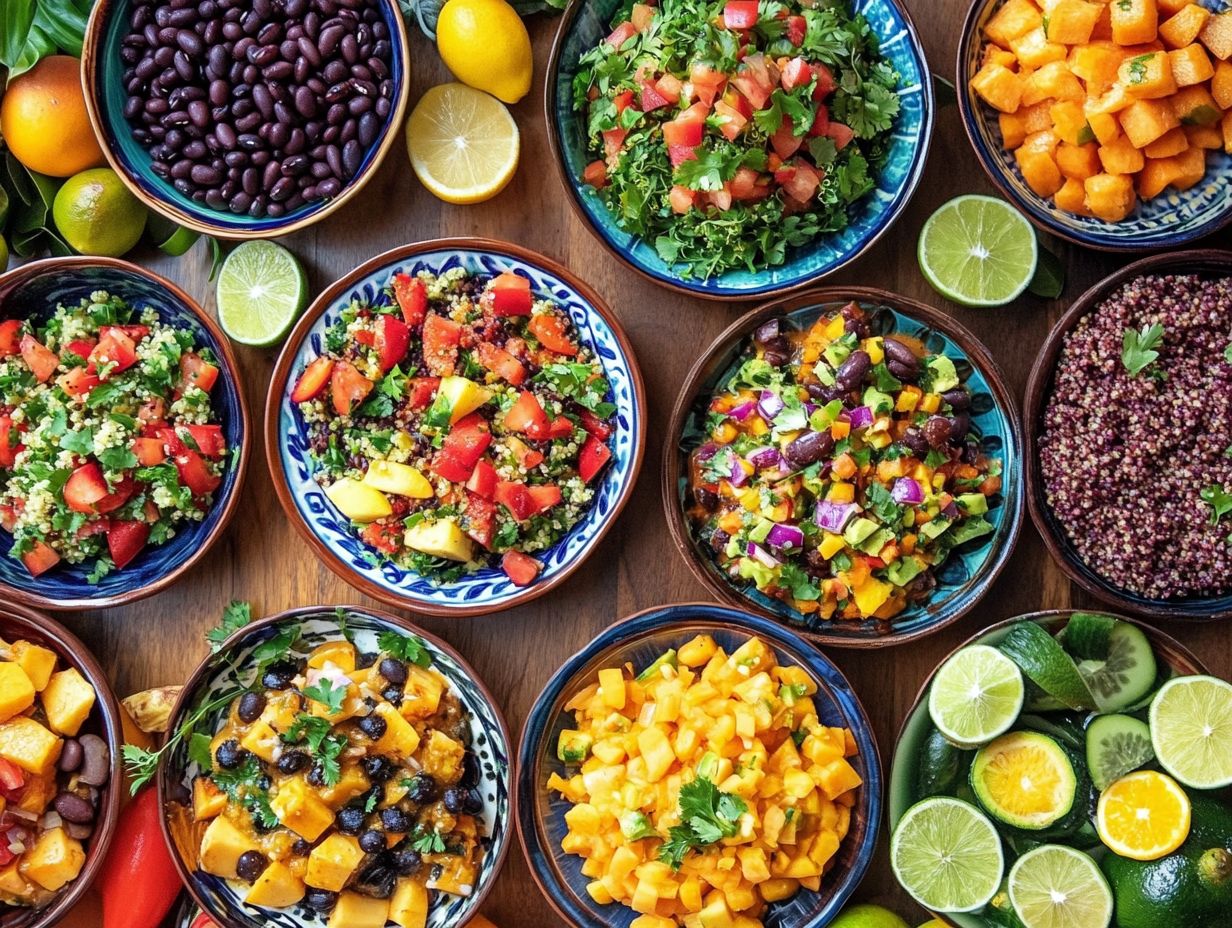 Vegan adaptations of popular Brazilian dishes allow plant-based eaters to savor the rich flavors of Brazilian cuisine, with variations that highlight the vibrant spices and vegetables intrinsic to these recipes. Vegan moqueca, made with a variety of vegetables like bell peppers and cooked in coconut milk, and vegan feijoada, a hearty stew of beans and plant proteins, are favorites among both vegans and non-vegans. Another beloved Brazilian comfort food is P o de Queijo (cheese bread), which can be modified to include vegan alternatives. This deliciously cheesy snack or meal can be enjoyed guilt-free with the use of vegan cheese. These comforting dishes not only celebrate Brazilian heritage but also demonstrate how culinary creativity can transform traditional recipes into delicious plant-based versions, inspiring community gatherings and cultural exchanges.
Vegan adaptations of popular Brazilian dishes allow plant-based eaters to savor the rich flavors of Brazilian cuisine, with variations that highlight the vibrant spices and vegetables intrinsic to these recipes. Vegan moqueca, made with a variety of vegetables like bell peppers and cooked in coconut milk, and vegan feijoada, a hearty stew of beans and plant proteins, are favorites among both vegans and non-vegans. Another beloved Brazilian comfort food is P o de Queijo (cheese bread), which can be modified to include vegan alternatives. This deliciously cheesy snack or meal can be enjoyed guilt-free with the use of vegan cheese. These comforting dishes not only celebrate Brazilian heritage but also demonstrate how culinary creativity can transform traditional recipes into delicious plant-based versions, inspiring community gatherings and cultural exchanges.
Feijoada
Vegan feijoada is a plant-based reinterpretation of Brazil’s beloved black bean stew, which traditionally includes a variety of meats. This modern version features hearty vegetables and spices that create a robust flavor profile, staying true to the essence of this iconic dish. Typically served with white rice and garnished with fresh herbs, vegan feijoada embodies the comfort food ethos of Brazilian cuisine. By incorporating ingredients such as smoked paprika and garlic, vegans can replicate the depth of flavor found in the original recipe while adhering to their dietary choices. The origins of feijoada date back to the 16th century, believed to be inspired by Portuguese stews and later embraced by Brazilian society, particularly among the enslaved population who utilized available ingredients to create a nourishing meal. Over time, feijoada has evolved into a national symbol of unity and celebration, often enjoyed during family gatherings and communal feasts, particularly during National Hispanic Heritage Month. In this vegan version, the rich diversity of flavors remains intact, allowing everyone to savor the heartiness of this dish without compromising their ethical beliefs. With the right combination of spices and plant-based proteins, this stew can serve as a memorable centerpiece for any meal, sparking rich discussions about cultural heritage and dietary adaptations.
Moqueca
Vegan moqueca is a Brazilian stew traditionally made with fish and seafood, but in a vegan version, it features fresh vegetables such as peppers and utilizes coconut milk to achieve a creamy texture. This dish is typically served over rice, with its flavors enhanced by spices like turmeric and lime juice. The vegan moqueca recipe represents a modern adaptation of a dish with roots in the Afro-Brazilian culture of the coastal regions of Brazil, where the use of ingredients like ginger and limes adds a refreshing twist to the traditional flavors. Historically, moqueca was a simple meal prepared with locally caught fish and seafood, served alongside rice. Over the years, indigenous and Portuguese influences have contributed to the evolution of the dish, resulting in various regional variations throughout Brazil.
Vegan Moqueca with Coconut Milk
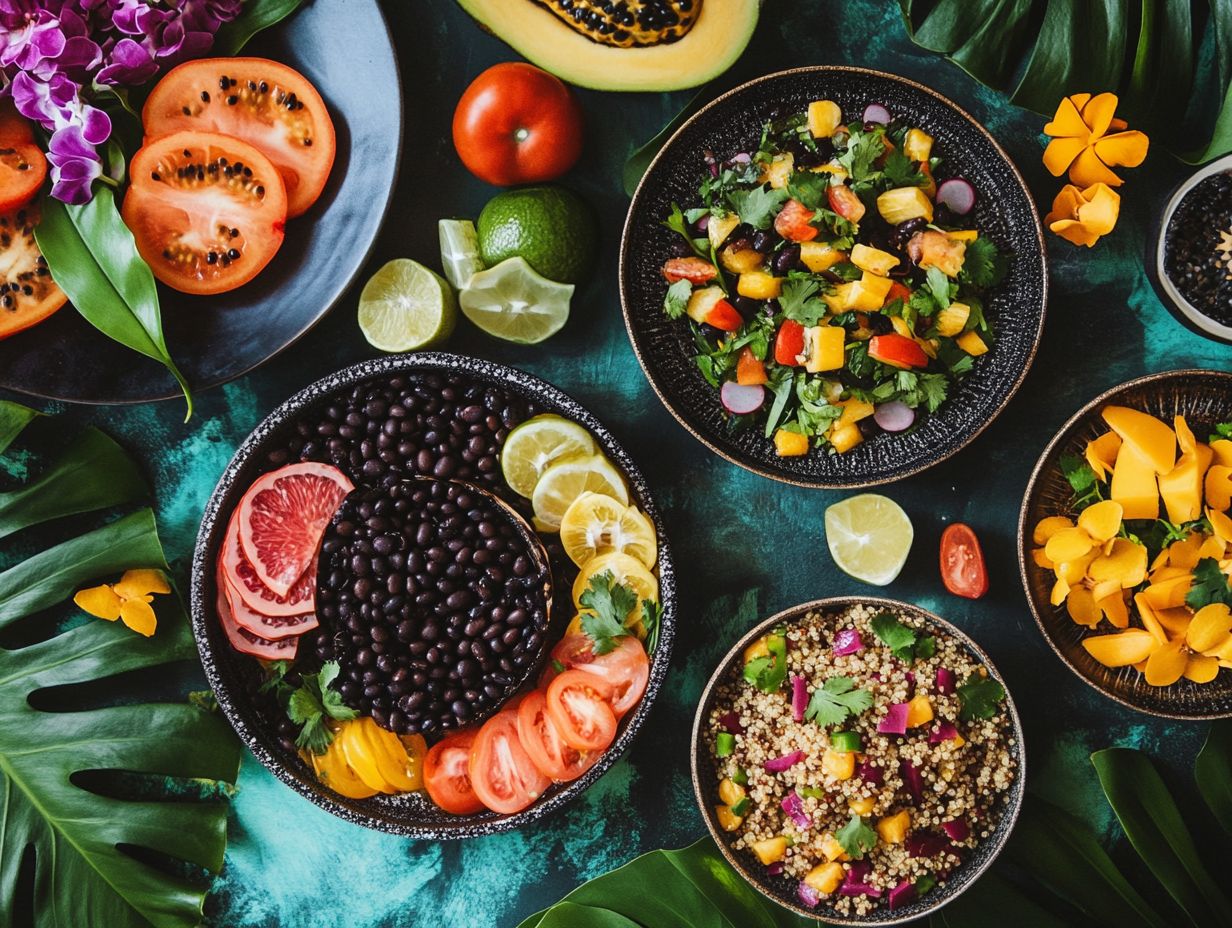
Ingredients:
- 2 tablespoons olive oil
- 1 medium onion, chopped
- 2 cloves garlic, minced
- 1 jalape o pepper, chopped
- 1 cups sliced yellow or green bell peppers
- 1 medium carrot, thinly sliced
- 1 medium yellow squash, diced
- 1 medium zucchini, diced
- 1 medium Japanese eggplant, diced
- 2 medium tomatoes, diced
- 1 teaspoon salt
- 1 can (14 oz) coconut milk
- 1 tablespoon lime juice
- 3 cups cooked rice
- 1 medium lime, sliced for serving
Preparation:
- In a large pot, heat the olive oil over medium heat. Add the chopped onion, minced garlic, and chopped jalape o pepper, saut ing for 1-2 minutes until fragrant.
- Add the yellow or green bell peppers, sliced carrot, yellow squash, zucchini, eggplant, and salt to the pot. Stir and cook for 3-4 minutes.
- Incorporate the diced tomatoes and coconut milk, stirring to combine. Cover the pot and allow the vegetables to simmer for 10-12 minutes until they soften.
- Stir in the lime juice. Serve warm over rice and garnish with lime slices.
Nutritional Information (per serving without rice):
- Calories: 236 kcal
- Carbohydrates: 14 g
- Protein: 2 g
- Fat: 21 g
- Saturated Fat: 18 g
- Sodium: 500 mg
- Fiber: 3 g
- Sugar: 5 g
P o de Queijo
Vegan P o de Queijo is a plant-based adaptation of Brazil’s beloved P o de Queijo (cheese bread), a popular snack traditionally made with cheese and tapioca flour that preserves the chewy texture and flavor of the original recipe. Like its traditional counterpart, it can be enjoyed at any time of day and serves as a delicious comfort food, showcasing the flavors of Brazil when made with vegan cheese substitutes. Additional spices can be incorporated to further enhance its flavor. Vegan P o de Queijo holds a significant place in Brazilian culture, often served at breakfast and enjoyed as a popular snack alongside coffee. The traditional recipe includes tapioca flour, cheese, eggs, and milk, resulting in a soft, airy texture that many people love. In Brazil, it is often enjoyed during breakfast or as a snack at cafes in cities like Barcelona. In the vegan version, ingredients such as nutritional yeast, almond milk, and blended cashews replace these components, making it accessible for those following a plant-based diet. This versatility makes it suitable for various occasions, whether as a casual snack or a dish for festive gatherings.
How to Incorporate Latin American Flavors into Vegan Cooking
Incorporating Latin American flavors into vegan cooking can enhance dishes by utilizing a diverse array of spices, fresh vegetables, and unique ingredients that reflect the vibrant culinary traditions of the region, particularly those from Brazil, such as acai and farofa, which add rich and varied textures to meals. By embracing aromatic spices such as cumin, coriander, and sweet paprika, along with fresh limes, cooks can recreate the depth and complexity that define traditional Latin American dishes. This approach ensures that plant-based meals are both exciting and satisfying. Additionally, creative cooking techniques that emphasize these flavors can transform everyday ingredients into a culinary celebration of Latin American cuisine.
Spices and Seasonings to Use
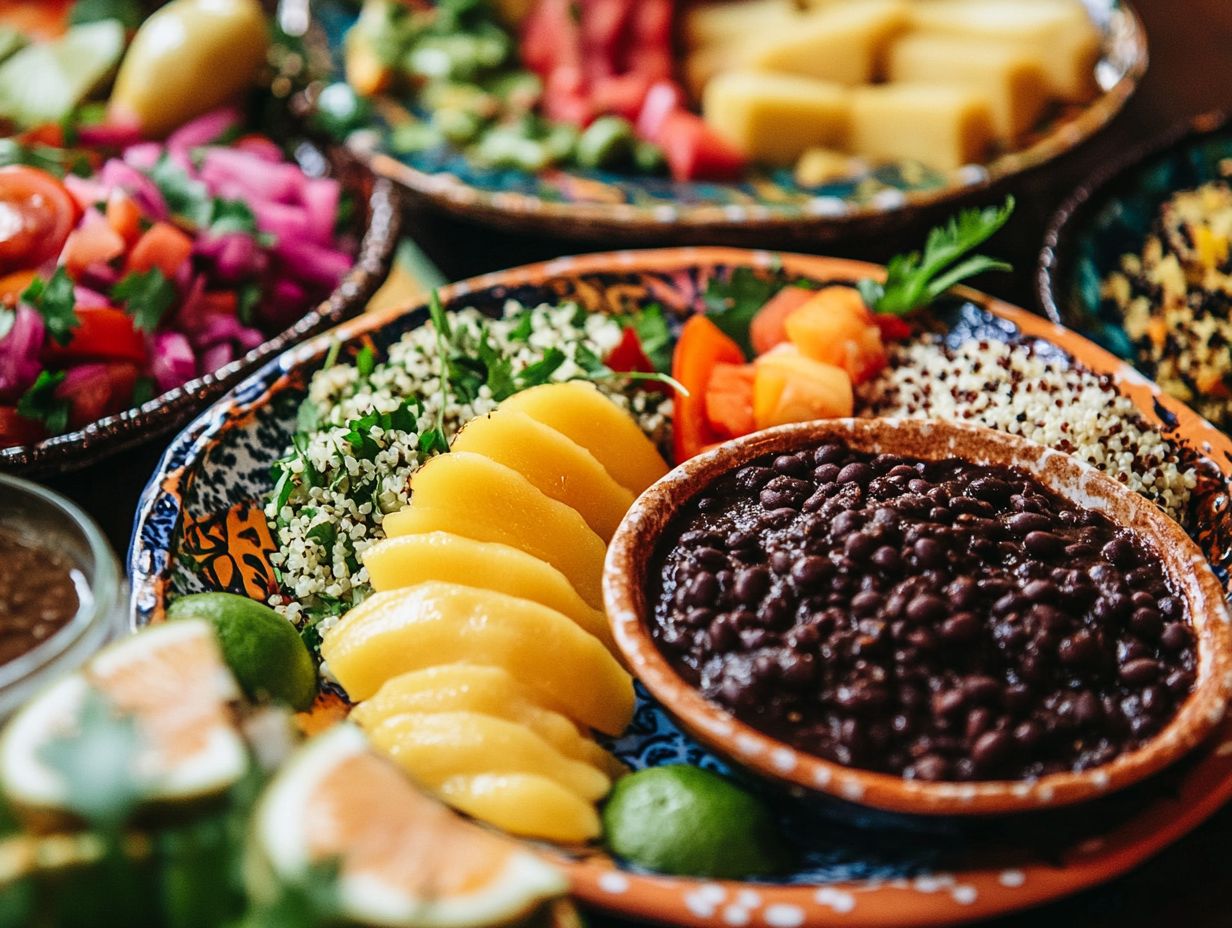 The right spices and seasonings are essential in vegan cooking to infuse dishes with authentic Latin American flavors, transforming simple meals into culinary masterpieces that celebrate the richness of Brazilian and Caribbean cuisines. Key spices such as turmeric, garlic, ginger, and lime enhance the taste of various vegetables and plant-based proteins, contributing depth and complexity to the flavors, making meals both savory and sweet. By emphasizing the balance of sweet and savory notes through the careful use of spices and local ingredients, vegan dishes can be elevated to appeal to a wide range of palates. Incorporating spices like earthy cumin and vibrant cilantro can transport your taste buds to the streets of S o Paulo, the beaches of Copacabana, or the markets of Mexico City. For instance, using smoked paprika not only adds color but also imparts a depth of flavor reminiscent of traditional dishes, while lime zest brilliantly brightens a plant-based stew or salad. Additionally, incorporating tropical fruits like plantain and banana can add unique twists to the dishes. The art of seasoning lies in layering; each spice complements the next, creating a harmonious symphony of flavors. Fresh herbs like oregano and unique spices like epazote create an authentic culinary experience reflecting the true heritage of Latin American cuisine. Experimenting with regional herbs like epazote or fresh oregano further enhances authenticity, ensuring that every vegan meal truly reflects the heart and soul of Latin American cuisine, as celebrated during National Hispanic Heritage Month.
The right spices and seasonings are essential in vegan cooking to infuse dishes with authentic Latin American flavors, transforming simple meals into culinary masterpieces that celebrate the richness of Brazilian and Caribbean cuisines. Key spices such as turmeric, garlic, ginger, and lime enhance the taste of various vegetables and plant-based proteins, contributing depth and complexity to the flavors, making meals both savory and sweet. By emphasizing the balance of sweet and savory notes through the careful use of spices and local ingredients, vegan dishes can be elevated to appeal to a wide range of palates. Incorporating spices like earthy cumin and vibrant cilantro can transport your taste buds to the streets of S o Paulo, the beaches of Copacabana, or the markets of Mexico City. For instance, using smoked paprika not only adds color but also imparts a depth of flavor reminiscent of traditional dishes, while lime zest brilliantly brightens a plant-based stew or salad. Additionally, incorporating tropical fruits like plantain and banana can add unique twists to the dishes. The art of seasoning lies in layering; each spice complements the next, creating a harmonious symphony of flavors. Fresh herbs like oregano and unique spices like epazote create an authentic culinary experience reflecting the true heritage of Latin American cuisine. Experimenting with regional herbs like epazote or fresh oregano further enhances authenticity, ensuring that every vegan meal truly reflects the heart and soul of Latin American cuisine, as celebrated during National Hispanic Heritage Month.
Vegan Brazilian Recipes to Try
Vegan Brazilian recipes enable food enthusiasts to savor the rich and diverse flavors of Brazil while adhering to plant-based dietary lifestyles. Popular dishes such as moqueca, feijoada, and P o de Queijo are expertly crafted to preserve their authentic taste, highlighting the influence of traditional Brazilian cooking techniques and ingredients. These vegan recipes showcase the versatility of plant-based cooking and provide insight into the culinary heritage of this beautiful country. Additionally, they make Brazilian cuisine accessible to those who may not be experienced cooks but wish to explore Latin American flavors and culinary traditions. Recipes for each dish often emphasize the cultural significance of the recipe and the regional ingredients that contribute to its unique character.
Recipe 1: Vegan Feijoada
This vegan feijoada recipe embodies the essence of Brazil’s traditional black bean stew, transforming it into a delightful plant-based dish that retains the hearty and flavorful characteristics of the original. Incorporating essential ingredients like black beans, garlic, onion, and farofa, this recipe stays true to its roots. By combining black beans with assorted vegetables and spices such as sweet paprika, garlic, and onions, this recipe produces a comforting meal that can be served with rice, farofa, or even cassava. This allows you to enjoy the rich culinary culture of Brazil in a vegan-friendly manner. Perfect for gatherings or family meals, it showcases the delicious possibilities of plant-based eating and highlights the vibrant culinary traditions of Brazil.
Recipe 2: Vegan Moqueca
Vegan Moqueca Recipe This vegan moqueca recipe features fresh vegetables, coconut milk, and aromatic spices, creating a thick and creamy version of Brazil’s most famous stew while staying true to its traditional roots. By incorporating plant-based ingredients alongside bell peppers, onions, ginger, and garlic, this recipe embodies the essence of Brazilian cuisine, making it a fantastic addition to any dinner table. Serve it with rice to complete the meal and embark on a tropical culinary journey that celebrates the historical influences of Bahia’s cuisine. Ingredients for Vegan Moqueca
- 8 oz. (226 g) firm tofu, drained and pressed
- 2 tbsp coconut oil
- 2 cups (473 ml) coconut milk (canned or carton)
- 1 cup (240 ml) vegetable stock
- 1 cup (150 g) chopped tomatoes
- 1 cup (150 g) diced green bell pepper
- 1 cup (150 g) diced red bell pepper
- 1 small onion, roughly chopped
- 4 cloves garlic, minced
- 1 tbsp grated ginger
- 1 tsp turmeric powder
- 1 tbsp lime juice
- 1 tbsp fresh cilantro, chopped
- Salt, to taste
Instructions for Vegan Moqueca
- Cut the pressed tofu into cubes and season them with salt.
- Heat the coconut oil over medium heat, then add the tofu cubes and cook until golden brown on all sides.
- Remove the tofu and saut the onions, garlic, ginger, and peppers until softened.
- Stir in the turmeric, lime juice, cilantro, tomatoes, and vegetable stock.
- Allow the mixture to simmer for 15 minutes.
- Add the coconut milk and tofu, then cook for an additional 5-10 minutes. Serve hot with rice.
Nutrition Information Per serving: 442 calories, 20 g protein, 30 g carbohydrates, 28 g fat, 6 g saturated fat, 2 g sugar, 9 g fiber, 706 mg sodium, 78 mg calcium, 5 mg iron. This recipe is adapted from the website Veg Recipes of India, with slight modifications to enhance its authenticity and flavors.
Recipe 3: Vegan P o de Queijo with a Modern Twist
This vegan P o de Queijo recipe reimagines Brazil’s beloved cheese bread using plant-based ingredients to create delicious, chewy, and flavorful snack bites that are perfect for any occasion. By incorporating tapioca flour and vegan cheese alternatives, this recipe preserves the traditional texture and taste of P o de Queijo while catering to a vegan lifestyle. These snacks also reflect the rich culinary history and community-centered traditions of Brazil. These delightful bites are ideal for parties or as a comforting treat to enjoy at home. With just a handful of simple ingredients, including tapioca flour and plant-based cheese, anyone can recreate this iconic snack in their own kitchen. To make these savory delights, you will need:
- 2 cups of tapioca flour
- 1 cup of unsweetened plant-based milk
- 1/4 cup of olive oil
- 1 cup of shredded vegan cheese
- A pinch of salt
Start by preheating the oven to 350 F (175 C). In a saucepan, combine the plant-based milk and olive oil, heating until warm but not boiling. Gradually mix the warm liquid into the tapioca flour and salt until well combined. Allow the mixture to cool slightly before kneading in the vegan cheese. Shape the dough into small balls and arrange them on a parchment-lined baking sheet. Bake for about 25 minutes, or until golden brown. For added flavor, consider incorporating spices like garlic powder or fresh herbs, and feel free to experiment with various vegan cheese blends to discover your perfect combination. Adding a touch of sweet corn or savory beans can provide delightful variations to this traditional recipe.
